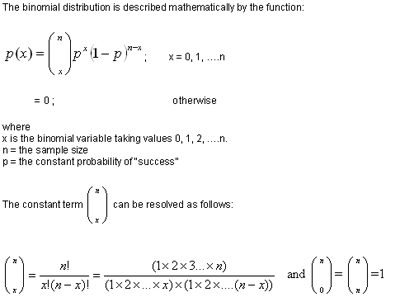Definition

The probability distribution describing the number of times that an event occurs out of n trials (e.g.: Number of Heads in 10 coin flips) with a specific probability of occurrence on each trial (if the coin is fair, P(Heads) = 0.5). The event under consideration is one of two possible outcomes, such as heads/tails for a coin, defective/non-defective for a product, etc.
Certain conditions need to be satisfied before a variable can be said to have a Binomial distribution:
1. There are a finite number of trials, n.
2. Each trial can result in one of two possible outcomes, for example ‘success’ or ‘failure’.
3. The probability of a ‘success’, say p, is constant across trials.
4. The n trials are independent i.e., the outcome of any given trial does not affect in any way the outcome of the next trial.
There are two parameters: n and p.
The mean = np and variance = np(1-p)
Examples
Consider a billing process with a 5% defective rate, i.e., 5 out of every 100 orders is billed incorrectly (p=0.05). In a random sample of 10 orders, what is the probability that at least one is incorrect?
P(at least 1 defective) =
P(none defective) = P(X = 0) = ( n0)*(0.05)0*(1-0.05)10-0 = 1*1*0.9510 = 0.6.
External Links
More on the Binomial Distribution from NIST: - http://www.itl.nist.gov/div898/handbook/eda/section3/eda366i.htm
